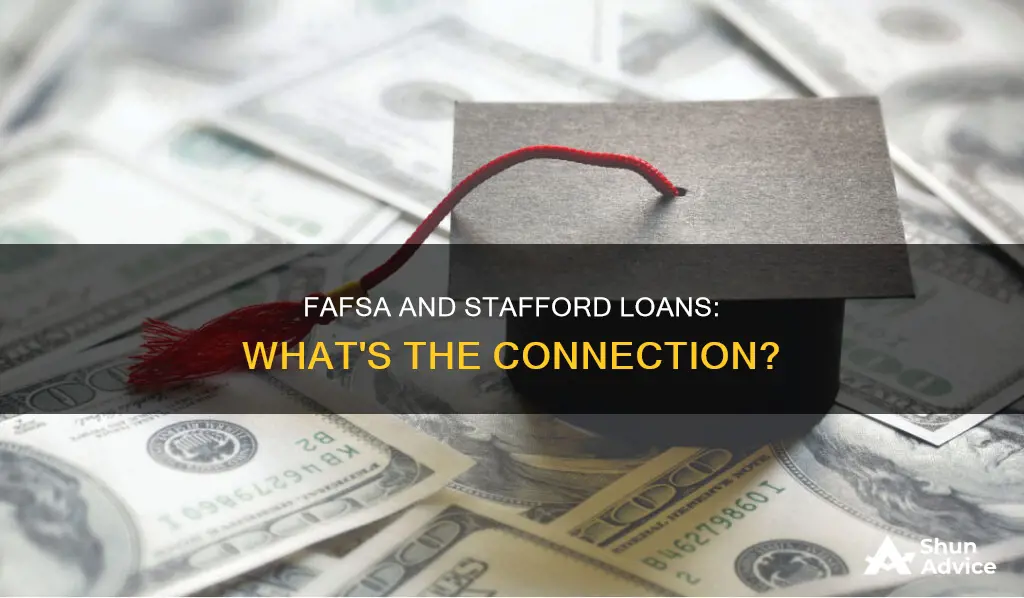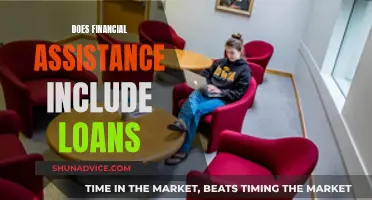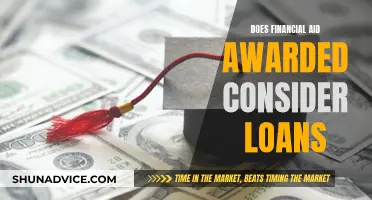
Stafford Loans are a type of federal student loan that are either subsidized, where the government pays the interest while the student is enrolled, or unsubsidized, where the student pays all the interest. To apply for a Stafford Loan, students must complete a Free Application for Federal Student Aid (FAFSA) form. This application is used to determine eligibility for a range of federal student loans, including Stafford Loans, Perkins Loans, and Direct Loans. However, it is important to note that Stafford Loans are no longer issued as of July 2010, and students now apply for Direct Subsidized and Unsubsidized Loans instead.
| Characteristics | Values |
|---|---|
| Application | To apply for a Stafford Loan, you must complete a Free Application for Federal Student Aid (FAFSA) form. |
| Interest | Stafford Loans are either subsidized, where the government pays the interest while the student is in college, or unsubsidized, where the student pays all the interest. |
| Grace Period | There is a six-month grace period, meaning the first payment is not due until six months after graduation, or when the borrower left school or dropped below half-time enrollment. |
| Repayment Options | Borrowers of Stafford Loans under the FFEL Program qualify for three repayment options: Income-Contingent Repayment Plan, Income-Based Repayment Plan, and Income-Sensitive Repayment Plan. |
| Loan Forgiveness | You may qualify for loan forgiveness if you teach full-time for five consecutive years in certain schools that serve low-income families, or if your school closes while you are enrolled or shortly after you withdraw. |
| Status | New Stafford Loans were not issued after July 2010, but millions of Americans still owe money on them. |
What You'll Learn

Subsidized vs. unsubsidized Stafford Loans
Stafford Loans are no longer issued as of July 2010, but millions of Americans still owe money on them. The term 'Stafford Loan' is also no longer technically correct, as a Stafford Loan was issued by a bank, credit union, or other lenders and then guaranteed by the government. A Federal Direct Loan is issued by the U.S. Department of Education or directly by the government.
However, the U.S. Department of Education still offers Direct Subsidized Loans and Direct Unsubsidized Loans. Both are low-interest federal student loans that can help you pay for college or career school. The main difference between the two is that with a Direct Subsidized Loan, the government pays the interest while the student is enrolled at least half-time, whereas with a Direct Unsubsidized Loan, interest starts accumulating from the date of the first loan disbursement.
To apply for either of these loans, you need to first complete the Free Application for Federal Student Aid (FAFSA) form. This application will be used to determine the different types and amounts of federal student aid available to you, including grants, scholarships, work-study funds, or student loans.
The other differences between these two loan types are the amount of total money you're allowed to borrow and the restrictions on who can borrow. The limit on how much you can borrow for each loan type depends on what year you are in school and whether you're a dependent or independent student. Direct Subsidized Loans are only available to undergraduate students who demonstrate a clear financial need, whereas Direct Unsubsidized Loans don't have any financial need requirements and can be taken out by both undergraduates and graduate students.
Fannie Mae Loans: Do You Need a Cash Cushion?
You may want to see also

FAFSA form requirements
Stafford Loans were previously issued by a bank, credit union, or other lenders and guaranteed by the government. Nowadays, no new applications are being accepted for Stafford Loans. Instead, students can apply for Direct Subsidized Loans and Direct Unsubsidized Loans. Applications for these loans are made by completing a Free Application for Federal Student Aid (FAFSA) form.
The FAFSA form can be started at fafsa.gov. To complete the form, you will need a StudentAid.gov account, tax and assets information, and a list of the schools you might attend. Before beginning the form, check which year's income and tax information you will need to report. This will be the year prior to your application. For example, if you are applying in 2023, you will need to report your 2022 income and tax information.
It is important to note that if you or another contributor on your form has had a significant change in income, you should still complete the FAFSA form as instructed. You can then contact the financial aid office at your school and request an aid adjustment. They will ask for more information and documentation of the change in income.
Additionally, several states require you to list schools in a particular order to be considered for state aid. For instance, you might need to list a state school first. Therefore, it is recommended to find out whether your state has any specific requirements for the order in which you list schools on the FAFSA form.
Fannie Mae and Freddie Mac: Partners or Rivals?
You may want to see also

Direct Loans vs. Stafford Loans
The main difference between Direct Loans and Stafford Loans is the entity that issues them. Direct Loans are issued by the U.S. Department of Education or directly by the government, whereas Stafford Loans were issued by a bank, credit union, or other lenders and then guaranteed by the government.
Stafford Loans are an older program, with the original law setting up federally guaranteed loans being the Higher Education Act of 1965. These loans were initially called FFELP loans, but in 1988, they were renamed in honour of Sen. Robert Stafford, a higher education advocate. In 2010, Congress stopped issuing new FFELP/Stafford Loans and started issuing new Direct Loans. No new applications can be made for Stafford Loans, and students now apply for Direct Subsidized and Unsubsidized Loans. As of the third quarter of 2024, 37.5 million Americans had Direct Loan debt, totalling $1.43 trillion.
Direct Loans include Subsidized and Unsubsidized Loans. Subsidized loans are available to undergraduate students only, and the government pays the interest while the student is in college. Unsubsidized loans, on the other hand, require the student to pay all the interest, which starts accruing immediately. Similarly, Stafford Loans also had Subsidized and Unsubsidized options. Subsidized Stafford Loans had a six-month grace period, meaning the first payment was not due until six months after graduation or leaving school. Unsubsidized Stafford Loans accrued interest while the borrower was in school, during grace periods and deferment periods. Students were not required to pay the interest during these periods, but if they chose not to, it was added to the principal loan amount.
While some schools, financial entities, and websites still use the term Stafford Loan, it is technically incorrect to do so. Although there are similarities between the two programs, Direct Loans and Stafford Loans are not the same.
Fannie Mae and Jumbo Loans: What You Need to Know
You may want to see also

Loan repayment options
Stafford Loans were issued by a bank, credit union, or other lenders and guaranteed by the government. They were given to students who had filled out a Free Application for Federal Student Aid (FAFSA) form. However, no new Stafford Loans have been issued since July 2010, and students now apply for Direct Subsidized Loans and Direct Unsubsidized Loans made under the William D. Ford Federal Direct Loan Program.
Stafford Loans have a six-month grace period, meaning that the first payment is not due until six months after graduation or when a student left school or dropped below half-time enrollment. The repayment period is 10 years, not including periods of deferment or forbearance. There is no penalty for early repayment.
Borrowers have the option of making a fixed monthly payment amount or a graduated payment amount that starts out lower and increases over time. The monthly payment amount will be at least $50, and borrowers will have up to 25 years to repay their loans (not including periods of deferment or forbearance).
The monthly payment amount will be based on the borrower's annual income, their spouse's income if they are married, their family size, and the total amount of their Direct Loans. Until the information needed to calculate the monthly payment amount is obtained, the payment will equal the amount of interest that has accrued on the loans unless the borrower requests forbearance.
The Journey's Loan: A Universal Experience?
You may want to see also

Loan forgiveness
Completing the FAFSA form was the application process for a Stafford Loan. Stafford Loans were issued by a bank, credit union, or other lenders and guaranteed by the government. However, no new applications can be made for Stafford Loans, and they have not been issued since July 2010. Instead, students can apply for Direct Subsidized Loans and Direct Unsubsidized Loans.
Federal student loan borrowers can be eligible for debt cancellation under income-driven repayment plans or if they become disabled, among other reasons. The US Department of Education oversees loan repayments and forgiveness. The terms and conditions of federal student loans cannot change, even if the agency overseeing them does.
If the Department of Education is not operating at full capacity, applications for existing loan forgiveness programs may be stalled.
There are several types of loan forgiveness programs. These include income-driven repayment plans, which can lead to loan forgiveness after a certain number of payments. Additionally, if a borrower becomes disabled, they may be eligible for loan forgiveness. It is important to note that the forgiveness process may be impacted by changes in the governing agencies.
It is recommended that individual borrowers keep records of their payments and stay updated on any changes to loan forgiveness programs.
Factoring: Understanding Loan Factor and Its Impact
You may want to see also
Frequently asked questions
Stafford Loans are a type of federal student loan that are either subsidized, meaning the government pays the interest while you're in school, or unsubsidized, meaning you pay all the interest.
Yes, you can apply for a Stafford Loan by completing a Free Application for Federal Student Aid (FAFSA) form.
You must complete a Master Promissory Note and Loan Entrance Counselling for undergraduates at Federal Student Aid. You will need your FSA ID.
No, they are not the same. A Stafford Loan was issued by a bank, credit union, or other lender and then guaranteed by the government. A Direct Loan is issued by the U.S. Department of Education or directly by the government.
No, Stafford Loans are no longer issued. The Federal Family Education Loan Program (FFELP) ended in July 2010, which stopped the issuing of new Stafford Loans.







